[English] 日本語
 Yorodumi
Yorodumi- PDB-6vif: Human LRH-1 ligand-binding domain bound to agonist cpd 15 and fra... -
+ Open data
Open data
- Basic information
Basic information
| Entry | Database: PDB / ID: 6vif | ||||||
|---|---|---|---|---|---|---|---|
| Title | Human LRH-1 ligand-binding domain bound to agonist cpd 15 and fragment of coregulator TIF-2 | ||||||
 Components Components |
| ||||||
 Keywords Keywords | NUCLEAR PROTEIN / ligand-binding domain / nuclear receptor / small molecule / agonist / liver receptor homolog-1 | ||||||
| Function / homology |  Function and homology information Function and homology informationpositive regulation of glucocorticoid biosynthetic process / zygotic genome activation / positive regulation of tendon cell differentiation / morula formation / Regulation of gene expression in early pancreatic precursor cells / primary ovarian follicle growth / pancreas morphogenesis / inner cell mass cell differentiation / tissue development / acinar cell differentiation ...positive regulation of glucocorticoid biosynthetic process / zygotic genome activation / positive regulation of tendon cell differentiation / morula formation / Regulation of gene expression in early pancreatic precursor cells / primary ovarian follicle growth / pancreas morphogenesis / inner cell mass cell differentiation / tissue development / acinar cell differentiation / Sertoli cell development / positive regulation of stem cell differentiation / positive regulation of T cell anergy / embryonic cleavage / embryo development ending in birth or egg hatching / bile acid metabolic process / exocrine pancreas development / cartilage development / negative regulation of chondrocyte differentiation / RNA polymerase II intronic transcription regulatory region sequence-specific DNA binding / homeostatic process / locomotor rhythm / calcineurin-mediated signaling / aryl hydrocarbon receptor binding / cellular response to Thyroglobulin triiodothyronine / regulation of glucose metabolic process / Synthesis of bile acids and bile salts / regulation of lipid metabolic process / somatic stem cell population maintenance / Synthesis of bile acids and bile salts via 27-hydroxycholesterol / Endogenous sterols / Synthesis of bile acids and bile salts via 7alpha-hydroxycholesterol / positive regulation of viral genome replication / Recycling of bile acids and salts / transcription regulator inhibitor activity / cellular response to hormone stimulus / hormone-mediated signaling pathway / : / positive regulation of adipose tissue development / Regulation of lipid metabolism by PPARalpha / positive regulation of T cell proliferation / neurogenesis / peroxisome proliferator activated receptor signaling pathway / regulation of cellular response to insulin stimulus / BMAL1:CLOCK,NPAS2 activates circadian expression / SUMOylation of transcription cofactors / response to progesterone / Activation of gene expression by SREBF (SREBP) / cholesterol homeostasis / nuclear receptor binding / cellular response to leukemia inhibitory factor / transcription coregulator binding / negative regulation of smoothened signaling pathway / SUMOylation of intracellular receptors / circadian regulation of gene expression / mRNA transcription by RNA polymerase II / Heme signaling / Transcriptional activation of mitochondrial biogenesis / PPARA activates gene expression / Cytoprotection by HMOX1 / Activated PKN1 stimulates transcription of AR (androgen receptor) regulated genes KLK2 and KLK3 / phospholipid binding / Transcriptional regulation of white adipocyte differentiation / Nuclear Receptor transcription pathway / positive regulation of T cell activation / negative regulation of inflammatory response / RNA polymerase II transcription regulator complex / nuclear receptor activity / sequence-specific double-stranded DNA binding / : / HATs acetylate histones / MLL4 and MLL3 complexes regulate expression of PPARG target genes in adipogenesis and hepatic steatosis / DNA-binding transcription activator activity, RNA polymerase II-specific / spermatogenesis / transcription regulator complex / sequence-specific DNA binding / Estrogen-dependent gene expression / DNA-binding transcription factor activity, RNA polymerase II-specific / transcription coactivator activity / transcription cis-regulatory region binding / protein dimerization activity / nuclear body / RNA polymerase II cis-regulatory region sequence-specific DNA binding / chromatin remodeling / DNA-binding transcription factor activity / protein domain specific binding / chromatin binding / regulation of DNA-templated transcription / regulation of transcription by RNA polymerase II / chromatin / positive regulation of DNA-templated transcription / negative regulation of transcription by RNA polymerase II / positive regulation of transcription by RNA polymerase II / protein-containing complex / DNA binding / zinc ion binding / nucleoplasm / nucleus / cytoplasm Similarity search - Function | ||||||
| Biological species |  Homo sapiens (human) Homo sapiens (human) | ||||||
| Method |  X-RAY DIFFRACTION / X-RAY DIFFRACTION /  SYNCHROTRON / SYNCHROTRON /  MOLECULAR REPLACEMENT / Resolution: 2.26 Å MOLECULAR REPLACEMENT / Resolution: 2.26 Å | ||||||
 Authors Authors | Cato, M.L. / Ortlund, E.A. | ||||||
| Funding support |  United States, 1items United States, 1items
| ||||||
 Citation Citation |  Journal: Bioorg.Med.Chem.Lett. / Year: 2020 Journal: Bioorg.Med.Chem.Lett. / Year: 2020Title: Development of a new class of liver receptor homolog-1 (LRH-1) agonists by photoredox conjugate addition. Authors: Cornelison, J.L. / Cato, M.L. / Johnson, A.M. / D'Agostino, E.H. / Melchers, D. / Patel, A.B. / Mays, S.G. / Houtman, R. / Ortlund, E.A. / Jui, N.T. #1: Journal: Acta Crystallogr.,Sect.D / Year: 2012 Title: Towards automated crystallographic structure refinement with phenix.refine. Authors: Afonine, P.V. / Grosse-Kunstleve, R.W. / Echols, N. / Headd, J.J. / Moriarty, N.W. / Mustyakimov, M. / Terwilliger, T.C. / Urzhumtsev, A. / Zwart, P.H. / Adams, P.D. #2: Journal: Acta Crystallogr D Biol Crystallogr / Year: 2010 Title: PHENIX: a comprehensive Python-based system for macromolecular structure solution. Authors: Paul D Adams / Pavel V Afonine / Gábor Bunkóczi / Vincent B Chen / Ian W Davis / Nathaniel Echols / Jeffrey J Headd / Li-Wei Hung / Gary J Kapral / Ralf W Grosse-Kunstleve / Airlie J McCoy ...Authors: Paul D Adams / Pavel V Afonine / Gábor Bunkóczi / Vincent B Chen / Ian W Davis / Nathaniel Echols / Jeffrey J Headd / Li-Wei Hung / Gary J Kapral / Ralf W Grosse-Kunstleve / Airlie J McCoy / Nigel W Moriarty / Robert Oeffner / Randy J Read / David C Richardson / Jane S Richardson / Thomas C Terwilliger / Peter H Zwart /  Abstract: Macromolecular X-ray crystallography is routinely applied to understand biological processes at a molecular level. However, significant time and effort are still required to solve and complete many ...Macromolecular X-ray crystallography is routinely applied to understand biological processes at a molecular level. However, significant time and effort are still required to solve and complete many of these structures because of the need for manual interpretation of complex numerical data using many software packages and the repeated use of interactive three-dimensional graphics. PHENIX has been developed to provide a comprehensive system for macromolecular crystallographic structure solution with an emphasis on the automation of all procedures. This has relied on the development of algorithms that minimize or eliminate subjective input, the development of algorithms that automate procedures that are traditionally performed by hand and, finally, the development of a framework that allows a tight integration between the algorithms. #3: Journal: Protein Sci. / Year: 2018 Title: MolProbity: More and better reference data for improved all-atom structure validation. Authors: Williams, C.J. / Headd, J.J. / Moriarty, N.W. / Prisant, M.G. / Videau, L.L. / Deis, L.N. / Verma, V. / Keedy, D.A. / Hintze, B.J. / Chen, V.B. / Jain, S. / Lewis, S.M. / Arendall 3rd, W.B. ...Authors: Williams, C.J. / Headd, J.J. / Moriarty, N.W. / Prisant, M.G. / Videau, L.L. / Deis, L.N. / Verma, V. / Keedy, D.A. / Hintze, B.J. / Chen, V.B. / Jain, S. / Lewis, S.M. / Arendall 3rd, W.B. / Snoeyink, J. / Adams, P.D. / Lovell, S.C. / Richardson, J.S. / Richardson, D.C. #4: Journal: J.Appl.Crystallogr. / Year: 2009 Title: PDB_REDO: automated re-refinement of X-ray structure models in the PDB. Authors: Joosten, R.P. / Salzemann, J. / Bloch, V. / Stockinger, H. / Berglund, A.C. / Blanchet, C. / Bongcam-Rudloff, E. / Combet, C. / Da Costa, A.L. / Deleage, G. / Diarena, M. / Fabbretti, R. / ...Authors: Joosten, R.P. / Salzemann, J. / Bloch, V. / Stockinger, H. / Berglund, A.C. / Blanchet, C. / Bongcam-Rudloff, E. / Combet, C. / Da Costa, A.L. / Deleage, G. / Diarena, M. / Fabbretti, R. / Fettahi, G. / Flegel, V. / Gisel, A. / Kasam, V. / Kervinen, T. / Korpelainen, E. / Mattila, K. / Pagni, M. / Reichstadt, M. / Breton, V. / Tickle, I.J. / Vriend, G. #5: Journal: Acta Crystallogr D Biol Crystallogr / Year: 2010 Title: Features and development of Coot. Authors: P Emsley / B Lohkamp / W G Scott / K Cowtan /  Abstract: Coot is a molecular-graphics application for model building and validation of biological macromolecules. The program displays electron-density maps and atomic models and allows model manipulations ...Coot is a molecular-graphics application for model building and validation of biological macromolecules. The program displays electron-density maps and atomic models and allows model manipulations such as idealization, real-space refinement, manual rotation/translation, rigid-body fitting, ligand search, solvation, mutations, rotamers and Ramachandran idealization. Furthermore, tools are provided for model validation as well as interfaces to external programs for refinement, validation and graphics. The software is designed to be easy to learn for novice users, which is achieved by ensuring that tools for common tasks are 'discoverable' through familiar user-interface elements (menus and toolbars) or by intuitive behaviour (mouse controls). Recent developments have focused on providing tools for expert users, with customisable key bindings, extensions and an extensive scripting interface. The software is under rapid development, but has already achieved very widespread use within the crystallographic community. The current state of the software is presented, with a description of the facilities available and of some of the underlying methods employed. | ||||||
| History |
|
- Structure visualization
Structure visualization
| Structure viewer | Molecule:  Molmil Molmil Jmol/JSmol Jmol/JSmol |
|---|
- Downloads & links
Downloads & links
- Download
Download
| PDBx/mmCIF format |  6vif.cif.gz 6vif.cif.gz | 141.2 KB | Display |  PDBx/mmCIF format PDBx/mmCIF format |
|---|---|---|---|---|
| PDB format |  pdb6vif.ent.gz pdb6vif.ent.gz | 91.8 KB | Display |  PDB format PDB format |
| PDBx/mmJSON format |  6vif.json.gz 6vif.json.gz | Tree view |  PDBx/mmJSON format PDBx/mmJSON format | |
| Others |  Other downloads Other downloads |
-Validation report
| Summary document |  6vif_validation.pdf.gz 6vif_validation.pdf.gz | 338.5 KB | Display |  wwPDB validaton report wwPDB validaton report |
|---|---|---|---|---|
| Full document |  6vif_full_validation.pdf.gz 6vif_full_validation.pdf.gz | 339.5 KB | Display | |
| Data in XML |  6vif_validation.xml.gz 6vif_validation.xml.gz | 1.6 KB | Display | |
| Data in CIF |  6vif_validation.cif.gz 6vif_validation.cif.gz | 4.4 KB | Display | |
| Arichive directory |  https://data.pdbj.org/pub/pdb/validation_reports/vi/6vif https://data.pdbj.org/pub/pdb/validation_reports/vi/6vif ftp://data.pdbj.org/pub/pdb/validation_reports/vi/6vif ftp://data.pdbj.org/pub/pdb/validation_reports/vi/6vif | HTTPS FTP |
-Related structure data
| Related structure data |  6oqyS S: Starting model for refinement |
|---|---|
| Similar structure data |
- Links
Links
- Assembly
Assembly
| Deposited unit | 
| ||||||||||||
|---|---|---|---|---|---|---|---|---|---|---|---|---|---|
| 1 |
| ||||||||||||
| Unit cell |
|
- Components
Components
| #1: Protein | Mass: 28330.693 Da / Num. of mol.: 1 Source method: isolated from a genetically manipulated source Source: (gene. exp.)  Homo sapiens (human) / Gene: NR5A2, B1F, CPF, FTF / Production host: Homo sapiens (human) / Gene: NR5A2, B1F, CPF, FTF / Production host:  |
|---|---|
| #2: Protein/peptide | Mass: 1708.931 Da / Num. of mol.: 1 / Source method: obtained synthetically / Details: fragment of coregulator Tif2 / Source: (synth.)  Homo sapiens (human) / References: UniProt: Q15596 Homo sapiens (human) / References: UniProt: Q15596 |
| #3: Chemical | ChemComp-QY4 / |
| #4: Water | ChemComp-HOH / |
| Has ligand of interest | Y |
-Experimental details
-Experiment
| Experiment | Method:  X-RAY DIFFRACTION / Number of used crystals: 1 X-RAY DIFFRACTION / Number of used crystals: 1 |
|---|
- Sample preparation
Sample preparation
| Crystal | Density Matthews: 1.98 Å3/Da / Density % sol: 37.84 % |
|---|---|
| Crystal grow | Temperature: 291.15 K / Method: vapor diffusion, hanging drop / Details: Na acetate (pH 4.6), PEG 4000, glycerol |
-Data collection
| Diffraction | Mean temperature: 100 K / Serial crystal experiment: N |
|---|---|
| Diffraction source | Source:  SYNCHROTRON / Site: SYNCHROTRON / Site:  APS APS  / Beamline: 22-ID / Wavelength: 1 Å / Beamline: 22-ID / Wavelength: 1 Å |
| Detector | Type: DECTRIS EIGER X 16M / Detector: PIXEL / Date: Oct 7, 2018 |
| Radiation | Protocol: SINGLE WAVELENGTH / Monochromatic (M) / Laue (L): M / Scattering type: x-ray |
| Radiation wavelength | Wavelength: 1 Å / Relative weight: 1 |
| Reflection | Resolution: 2.26→42.6 Å / Num. obs: 12218 / % possible obs: 99.74 % / Redundancy: 16.3 % / Rpim(I) all: 0.05 / Rrim(I) all: 0.217 / Net I/av σ(I): 17.1 / Net I/σ(I): 10.8 |
| Reflection shell | Resolution: 2.26→2.34 Å / Num. unique obs: 2148 / Rrim(I) all: 0.903 |
- Processing
Processing
| Software |
| ||||||||||||||||||||||||||||||||||||||||
|---|---|---|---|---|---|---|---|---|---|---|---|---|---|---|---|---|---|---|---|---|---|---|---|---|---|---|---|---|---|---|---|---|---|---|---|---|---|---|---|---|---|
| Refinement | Method to determine structure:  MOLECULAR REPLACEMENT MOLECULAR REPLACEMENTStarting model: 6OQY Resolution: 2.26→42.64 Å / SU ML: 0.2658 / Cross valid method: FREE R-VALUE / σ(F): 1.36 / Phase error: 31.8433 / Stereochemistry target values: CDL v1.2
| ||||||||||||||||||||||||||||||||||||||||
| Solvent computation | Shrinkage radii: 0.9 Å / VDW probe radii: 1.11 Å / Solvent model: FLAT BULK SOLVENT MODEL | ||||||||||||||||||||||||||||||||||||||||
| Displacement parameters | Biso mean: 68.25 Å2 | ||||||||||||||||||||||||||||||||||||||||
| Refinement step | Cycle: LAST / Resolution: 2.26→42.64 Å
| ||||||||||||||||||||||||||||||||||||||||
| Refine LS restraints |
| ||||||||||||||||||||||||||||||||||||||||
| LS refinement shell |
| ||||||||||||||||||||||||||||||||||||||||
| Refinement TLS params. | Method: refined / Origin x: -10.4892848141 Å / Origin y: 12.6667375961 Å / Origin z: -13.305124743 Å
| ||||||||||||||||||||||||||||||||||||||||
| Refinement TLS group | Selection details: all |
 Movie
Movie Controller
Controller


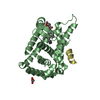
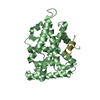
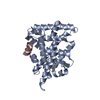

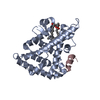
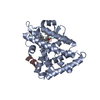
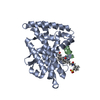
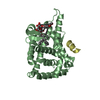
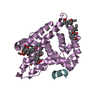
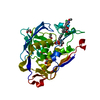
 PDBj
PDBj












